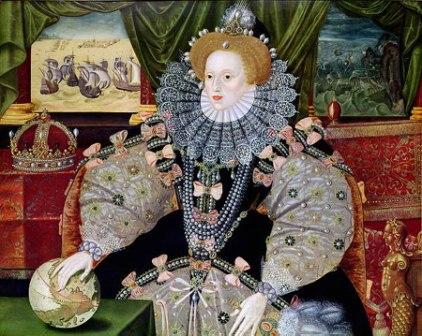The previous year, the First War of Religion had started in France, and the French Protestants, known as the Huguenots, were being persecuted by their countrymen, and more specifically the House of Guise. The Huguenots appealed to the greatest Protestant Queen in Europe, Queen Elizabeth, for help. Despite Elizabeth's skepticism in involving her country in foreign affairs, she decided to send military aid to the city of Le Havre, which the Huguenots were attempting to hold under a siege; the siege was led by the Catholic Francois, Duke de Guise. The Huguenots had promised to give Le Havre to Queen Elizabeth if she would help them (Wagner, 89). This was a tantalizing proposition, since her sister Queen Mary I had lost England's last foreign land possession, Calais in 1558 before she died.
 |
| A portrait of Queen Mary of England. Picture acquired through Wikimedia Commons. Image public domain. |
Elizabeth chose Ambrose Dudley, the Earl of Warwick to lead the relief force of 6,000 men. Warwick was the brother of her longtime friend and favorite Robert Dudley. Robert had himself expressed interest in delivering the Huguenots and thus the city of Le Havre in Queen Elizabeth's name, but she denied him permission to part from her.
 |
| An engraving from 1620 by Willem de Passe of Ambrose Dudley, the Earl of Warwick (1530-1590). Picture acquired through Wikimedia Commons. Image public domain. |
Once the Earl of Warwick arrived in October, it became clear that the situation was less than hopeful. Warwick and his soldiers waited for further instructions from the Queen, and by March 18th of the following year the French had solved their own dispute by agreeing to a truce, negotiated in part by Catherine de Medici after the death of her son the Duke de Guise. The treaty that brought about the end of the First War of Religion was called the Edict of Amboise. Elizabeth instructed Warwick to hold Le Havre until the French agreed to make an exchange for it with the English ancestral city of Calais (Wagner, 182). Unfortunately for Warwick and his men, the Huguenots, in a desperate attempt to prove their new-found loyalty to the Guise family, turned against the English.
Warwick bravely held the poorly fortified medieval city until July of 1563 when, with his men dying of plague around him, and his wife back in England having died in his absence, Queen Elizabeth granted him permission to surrender the city and return home (Wagner, 308). In a further affront by the French, the Earl of Warwick was dishonorably shot in the leg amidst negotiations, and the wound festered so badly that by the time he arrived in Portsmouth, he was gravely ill. Warwick would recover, but the bullet wound would bother him for the rest of his life, and it tragically prevented him from accepting any of the honorable military posts that Queen Elizabeth considered him for. However, he would serve as commissioner at the trial of Thomas Howard, the 4th Duke of Norfolk, for treason (Wagner, 89).
Though the Earl of Warwick and his men were finally home, the English involvement with Le Havre and the French was not over until the Treaty of Troyes was signed on April 11th of 1564. Elizabeth's two ambassadors in France, Sir Nicholas Throckmorton and Sir Thomas Smith negotiated the terms of the treaty. The final document did not dictate the return of Calais to the English crown, though the French did frustratingly acknowledge the English's right to Calais in it, based on the 1559 Treaty of Cateau-Cambresis (Wagner 54, 309). Elizabeth would not even get to keep the city of Le Havre; instead, she was paid 120,000 crowns, which was 20,000 crowns less than she had originally loaned the Huguenots.
Still, the Treaty of Troyes was somewhat victorious in that it improved relations between England and France for some time. In 1572 the two countries would sign The Treaty of Blois, which recognized the growing threat of Spain and bound France and England to support one another in the tumult ahead (Wagner 31, 309).
Queen Elizabeth had tried to recover Calais for England; its historical and strategic significance for England was certainly not lost on her. Interestingly, Calais was also the same city that King Henry VIII and Anne Boleyn had visited together, and it is probably the city where Elizabeth herself was conceived (Denny).
Elizabeth was not a woman to easily forget, and her experience with the Huguenots further developed what would come to be a characteristic apprehension to getting involved in foreign affairs, such as with the Dutch in the near future. None of Queen Elizabeth's councilor's were able to persuade her to aid the Huguenot's in their struggle against the French Crown and The Catholic League ever again (Wagner, 309).
 |
| A composite image of Elizabeth's parents, King Henry VIII and Queen Anne Boleyn. Picture acquired through Wikimedia Commons. Image public domain. |
Sources:
Wagner, John A. The Historical Dictionary of the Elizabethan World. Print.
(Pages 31, 54, 89-90, 182, 308-309)




